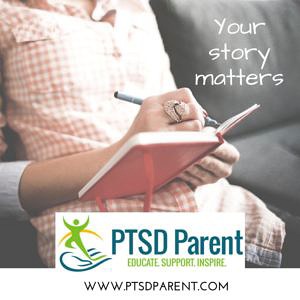“I would love for you to tell your PTSD story. I will give you ten minutes.”
This is a common direction that I receive as a speaker and comedian. Whether I am telling a set of jokes about mental illness at an evening event or speaking about my story at a conference, there is a definite time limit that I must respectfully stick to. The same is true of writing and submitting my PTSD story – a minimum of 500 words and often no more than 1200 total.
I wrote last week about wanting this community to be a safe space for people to share their stories about PTSD, abuse, and trauma. However, I also realize that this can feel overwhelming if not impossible. Here are some helpful steps to be able to tell your story without losing your mind.
Believe That Sharing Your Story is Healing
 As a whole, I have found that people are uncomfortable as I continue to talk about my experiences with abuse and healing. They want me to “be done,” even if they have the best of intentions. Believe me, I would like to “be done” too, and I get it.
As a whole, I have found that people are uncomfortable as I continue to talk about my experiences with abuse and healing. They want me to “be done,” even if they have the best of intentions. Believe me, I would like to “be done” too, and I get it.
What they don’t realize is that while we will never “get over it,” we do experience significant healing through telling our stories – sometimes over and over and over again. Part of the process is to believe – sometimes over and over and over again – that your story is important.
Your voice is needed. Your story matters. You matter.
Testify! Your PTSD Witness
With your belief in place, it’s time to testify. When I was a teen and part of an active youth group, I learned how to tell my testimony in front of groups. These skills transfer over.
This is what I like to call, “The Testimony Structure” –
- Share how my life was before a Big Thing (person, event) happened
- How the Big Thing changed everything
- How my life is better now/what I’ve learned
Whenever I need to tell some aspect of my story, I turn to this structure to help. When I need to give an overview of my story, the Big Thing is when my father-in-law died, I slid into a breakdown, and was finally given my diagnosis. If I need to talk about something more specific, like triggers for example, the Big Thing can be one of my more life-changing triggers.
This structure can help keep you on track, focused on telling your story in ten minutes or 500 to 1000 words.
Use Headlines, Not Details
 Post Traumatic Stress Disorder develops as a result of trauma. Our stories are bound to be disturbing, which is what makes them so healing to share. While it might be valuable to write down every single thing that happened, it’s important to keep a sense of time and place in mind.
Post Traumatic Stress Disorder develops as a result of trauma. Our stories are bound to be disturbing, which is what makes them so healing to share. While it might be valuable to write down every single thing that happened, it’s important to keep a sense of time and place in mind.
Whenever we need to share experiences in supports groups I’ve been in, the rule has always been, “Use headlines, not details.” A headline would be, “I am an adult survivor of childhood sexual abuse.” The details would be far more hair-raising; I have written them, but rarely have shared them.
There are exceptions to rules, of course – if details must be included, it’s a good idea to put a Trigger Warning at the top of whatever is shared. This allows people who might be triggered by the information to decided if they are mentally and emotionally prepared to get into it.
How to Share Your Story With PTSD Parent
My plan is to begin accepting submissions very soon. I will happily accept articles from parents about various aspects of what it’s like to live and parent with Post Traumatic Stress Disorder. Sign up for email in order to be sure when I’ll start accepting submissions.
The guidelines are:
- Articles related to PTSD (preferably with a parenting angle)
- Minimum 500 words, carefully edited
- Maximum three links in article and bio
- No affiliate links
Now that you know the guidelines, get your story ready! I can’t wait to read and share your story!